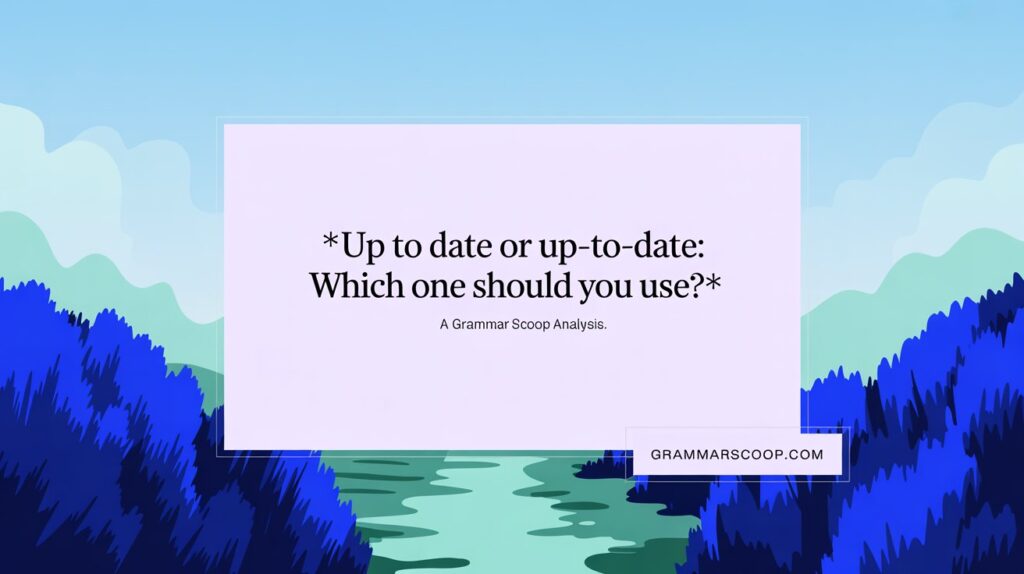Understanding the difference between “up to date” and “up-to-date” might seem like a tiny detail, but it can make or break the clarity of your writing. Whether you’re polishing a business report, updating your resume, or simply writing an email, knowing how to write “up to date” correctly helps your message land smoothly.So let’s get straight to it—because whether it’s Up to Date or Up-to-Date, knowing the right form makes all the difference.
Quick Summary
Use “up to date” (no hyphens) when you’re describing a state of being, like “The records are up to date.” Use “up-to-date” (with hyphens) when it comes before a noun, like “an up-to-date version.” Yes, hyphens matter!
Why the Confusion Between “Up to Date” and “Up-to-Date”?

The confusion arises because these phrases sound the same, but their grammatical function is different. One is an adverbial phrase, and the other is a compound adjective.
Here’s where people often trip up:
- Is “up to date” hyphenated in all cases?
- Can I use it the same way in every sentence?
- Do I just trust grammar checkers?
Let’s remove the guesswork.
What Each Form Actually Means
What Does “Up to Date” Mean?
“Up to date” is an adverbial phrase. It usually follows linking verbs and describes the condition of being current.
Example: “Your antivirus software is up to date.”
Key traits:
- Follows verbs like is, are, was, were, keep, stay
- Describes a condition, not a noun
- No hyphens needed
This form answers: “Is it current?”
What Does “Up-to-Date” Mean?
“Up-to-date” is a compound adjective used to modify a noun.
Example: “You need an up-to-date resume.”
Key traits:
- Comes before a noun
- Always hyphenated
- Describes the quality of something
This form answers: “What kind of (thing)?”
Grammar Rule Breakdown
When to Use “Up to Date” (No Hyphens)
This form appears:
- After a verb
- At the end of a clause
- When not directly modifying a noun
Examples:
- “Her vaccinations are up to date.”
- “He kept the files up to date.”
- “Our software stays up to date automatically.”
Remember: If it follows the verb and doesn’t touch a noun directly, skip the hyphens.
When to Use “Up-to-Date” (Hyphenated)
This form appears:
- Before a noun
- As part of a compound adjective
Examples:
- “An up-to-date app”
- “Up-to-date research is crucial”
- “Check the up-to-date report”
If you’re modifying a noun with the phrase, you must use hyphens. Simple.
Explore further:
- Feel Or Feal: Don’t Mix Up These Similar Words
- Pre vs Post: Which Prefix to Use and Why It Matters
- Long Term or Long-Term: What’s the Right Choice in Writing?
- What’s the Past Tense of Tear? Is it Tore, Teared, or Torn?
- excel vs accel: What Is the Correct Spelling?
Usage Table: Up to Date vs. Up-to-Date

| Phrase | Function | Placement | Example | Hyphenated? |
|---|---|---|---|---|
| up to date | Adverbial phrase | After the verb | “Make sure your files are up to date.” | No |
| up-to-date | Adjective phrase | Before a noun | “An up-to-date policy is important.” | Yes |
Real-World Examples in Sentences
“Up to Date” in Action
- “His medical records are up to date.”
- “We need to keep our employee list up to date.”
- “The database is not up to date.”
Common mistake: Writing “The database is up-to-date.” (Incorrect unless it’s part of a modifier before a noun.)
“Up-to-Date” in Action
- “She brought an up-to-date portfolio to the interview.”
- “An up-to-date operating system helps with security.”
- “This is an up-to-date list of suppliers.”
Pro tip: If you can insert the phrase before a noun without it sounding off, it probably needs hyphens.
Synonyms and Alternatives
Sometimes, repeating “up to date” can feel clunky. Here are smart alternatives depending on the phrase’s function.
Synonyms for “Up to Date” (Adverbial)
- Current
- Informed
- Caught up
- Not outdated
Synonyms for “Up-to-Date” (Adjective)
- Modern
- Latest
- Current
- State-of-the-art
- Updated
Choosing the Right Term Based on Tone
| Context | Formal Alternative | Casual Alternative |
|---|---|---|
| Resume | “current” | “up-to-date” |
| Medical field | “latest” | “updated” |
| Technology | “state-of-the-art” | “modern” |
Common Mistakes and How to Avoid Them

Mistakes mostly stem from not understanding grammar roles. Here’s what to look out for:
1: Using Hyphens After a Verb
- Incorrect: “My records are up-to-date.”
- Correct: “My records are up to date.”
2: Leaving Out Hyphens Before a Noun
- Incorrect: “This is an up to date report.”
- Correct: “This is an up-to-date report.”
3: Overusing the Phrase
- Instead of: “Stay up to date with the up-to-date system…”
- Try: “Stay current with the updated system…”
Origins and Evolution of the Phrase
Historical Usage of “Up to Date”
The expression first appeared in the late 1800s, referring to being informed up to the current date. Early uses were seen in newspapers and educational texts.
“Our data is up to date until the 1st of June.” — The Times (1893)
Rise of the Hyphenated Adjective “Up-to-Date”
The hyphenated version gained traction as writers began using it as a single descriptive unit for nouns, especially in editorial and formal writing.
Style guides like the AP Stylebook and Chicago Manual of Style started reinforcing its proper use for compound modifiers.
Style Guide Recommendations
Wondering what professionals say about this? Let’s look at the big names:
- APA Style: Use “up to date” (no hyphen) unless directly modifying a noun.
- AP Stylebook: Always hyphenate when used as a compound adjective.
- Chicago Manual of Style: Consistency matters more than anything. Follow grammar rules.
Quick rule: “Is up to date hyphenated?” Only when it describes a noun. Period.
SEO & Digital Writing Tips
- In titles and headings, hyphenate when it’s an adjective (e.g., “Up-to-Date Resources”)
- In blog posts, always double-check if the phrase is modifying a noun or not
Final Thoughts: Choosing the Right Form Every Time
To recap:
- Use “up to date” when describing a current condition or state
- Use “up-to-date” when describing a noun
Still unsure? Run this quick test:
- Can the phrase be removed and replaced with “modern” or “updated” before the noun?
- If yes, hyphenate it.
- If it follows a verb like “is” or “keep,” don’t hyphenate.
Downloadable Resources
- PDF Cheat Sheet: When to Hyphenate “Up to Date”
- Grammar Quiz: Up to Date vs. Up-to-Date
- Printable Reference Chart
Bonus: Quick Hyphenation Reference
| Sentence | Correct Form |
|---|---|
| “Keep your records ___” | up to date |
| “An ___ checklist is essential” | up-to-date |
| “Is the information ___?” | up to date |
| “This ___ software improves performance” | up-to-date |
TL;DR: Is Up to Date Hyphenated?
- Only when it’s an adjective: “up-to-date guide”
- Never when used as a predicate: “is up to date”
Now you’re not just up to date—you’re officially up-to-date on up to date or up-to-date.
Want more grammar breakdowns like this? Bookmark this guide, and keep your content crisp, correct, and compelling.

Lisa Morris is a seasoned blogger and language enthusiast with a passion for making grammar simple and engaging. At Grammar Scoop, she shares clear, concise tips that help readers master the rules of English with confidence.






